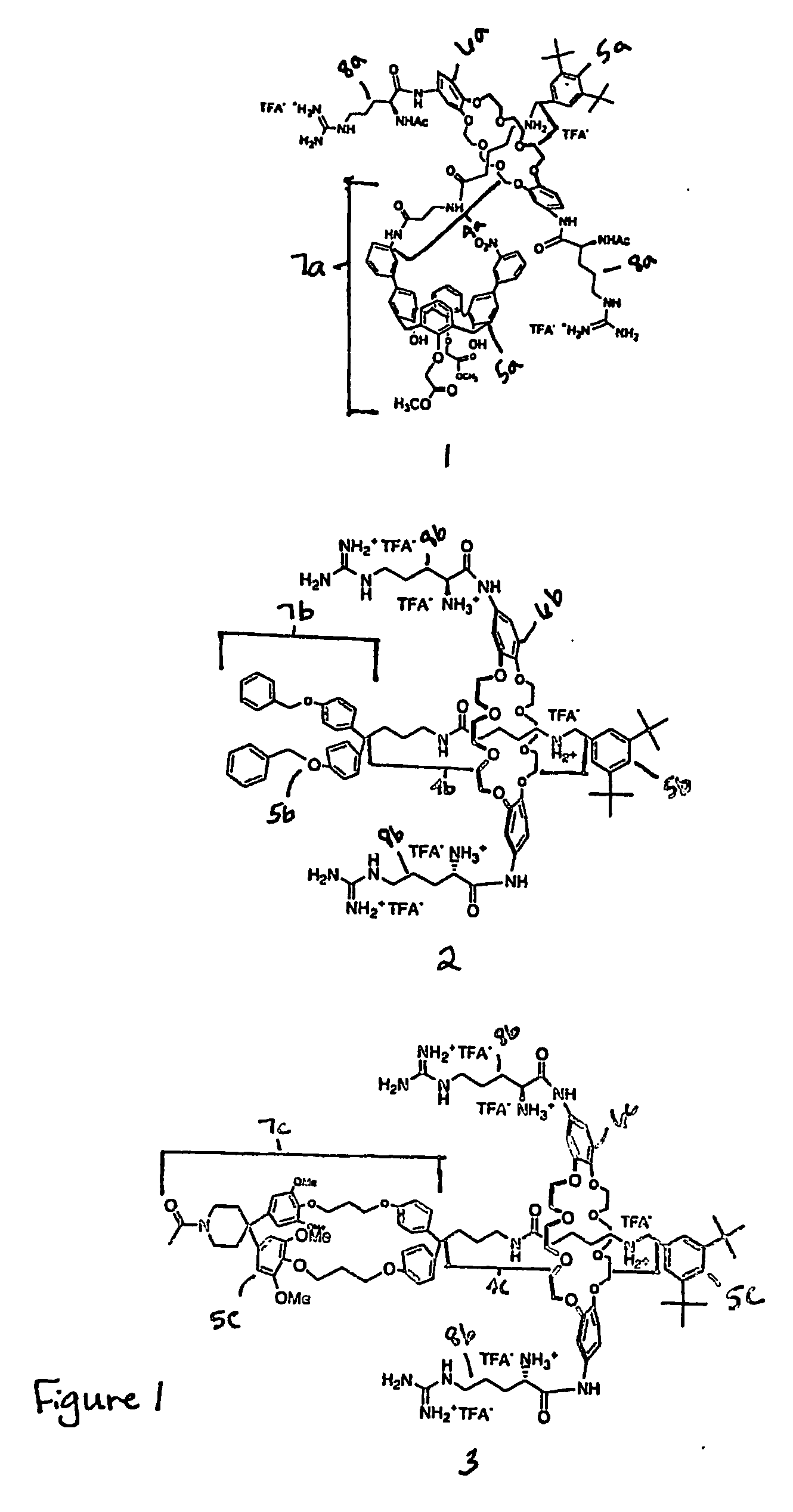Compositions and methods for targeted drug delivery
a technology of rotaxanes and synthetic hosts, applied in the field of synthetic host rotaxanes, can solve the problems of limiting current interest and research into rotaxanes, the arrangement of functional groups used, and the failure of many synthetic host constructions to provide functional groups that are truly convergent, so as to prevent pathological disorders, prevent pathological disorders, and prevent pathological disorders
- Summary
- Abstract
- Description
- Claims
- Application Information
AI Technical Summary
Benefits of technology
Problems solved by technology
Method used
Image
Examples
example 1
[0274] Host-[2]rotaxanes are easily constructed using our DCC-[2]rotaxane method (FIG. 23). The unique architecture of rotaxanes, composed of interchangeable parts: axle, hosts, and blocking groups, and ring, (see compound 7) reduces the synthetic burden of creating many compounds. Although the ring exists as a mixture of syn and anti isomers, molecular modeling results show that both isomers bind guests equivalently. Single isomers are being synthesized.
[0275] The high yielding and straightforward route by swapping various blocking groups, allows the attachment of cell-targeting groups (steroids and peptides) and fluorophores. The addition of more biologically stable recognition elements, e.g., alkyl guanidine instead or arginine, can be accomplished by adding (Boc)3-guanidine-(CH2)3—CO2DCC or other activated peptidomimetics in step two of FIG. 23.
[0276] The DCC-rotaxane method allows the combination of various binding pockets or clefts and the easy attachment of recognition elem...
example 2
[0277] Host-[2]rotaxane 1 was designed to selectively bind large aromatic acids, such as fluorescein. It binds fluorescein in water (10 add phosphate buffer pH 7.0, 1% DMSO) with a KA=5×106 M−1. This complex is preferred by 3 kcal / mol over the binding of other fluorophores (Dansyl and pyrene) and N-Ac-Trp and 7 kcal / mol over N-Ac-Gly (Graph 1A). [2]Rotaxanes 2 and 3 are also selective for fluorescein. They bind fluorescein in water with a KA=7×10 M−1 and in DMSO with a KA=9×105 M−1 (Graph 1B). This complex in both solvents is preferred by 1 kcal / mol over the binding of other fluorophores (Dansyl and pyrene) and N-Ac-Trp. Most likely, 4 and a 6 kcal / mol preferences exist for the association of fluorescein by rotaxanes 2 and 3 compared to Ac-Gly in DMSO and water, respectively. The values for Ac-Gly are taken from the studies of host-[2]rotaxane 1, which arise through a salt bridge between the Arg moiety of the ring and the carboxylate of Ac-Gly. This type of salt bridge should also e...
example 3
[0279] Rotaxane 3 associates with FITC-anti-goat (rabbit) antibody in buffer (KA=8×105 M−1, phosphate, pH 7, FIG. 18A) and in full fetal bovine serum (KA=1×104 M−1, FIG. 18B). The ADCT method relies on Fl-antibody association and cellular transport.
[0280] The following examples demonstrate transportation and transporter stability.
PUM
| Property | Measurement | Unit |
|---|---|---|
| molecular weight | aaaaa | aaaaa |
| time | aaaaa | aaaaa |
| pH | aaaaa | aaaaa |
Abstract
Description
Claims
Application Information
 Login to View More
Login to View More - R&D
- Intellectual Property
- Life Sciences
- Materials
- Tech Scout
- Unparalleled Data Quality
- Higher Quality Content
- 60% Fewer Hallucinations
Browse by: Latest US Patents, China's latest patents, Technical Efficacy Thesaurus, Application Domain, Technology Topic, Popular Technical Reports.
© 2025 PatSnap. All rights reserved.Legal|Privacy policy|Modern Slavery Act Transparency Statement|Sitemap|About US| Contact US: help@patsnap.com



